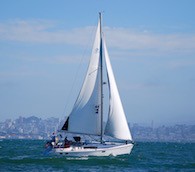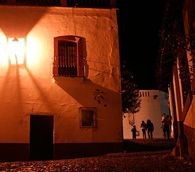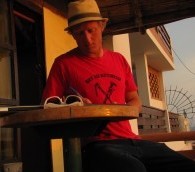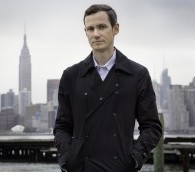Destination: North America
Riding the Slot
by Lenore Greiner | 03.19.16 | 12:09 PM ET
As she struggled to make sense of her father's final days, Lenore Greiner sailed across a treacherous patch of San Francisco Bay
A Not-So-Literary Tour of South-Central Mexico
by Peter Ferry | 06.27.15 | 4:11 PM ET
Peter Ferry made the trip based on a story he'd heard about Hemingway's Lady Brett Ashley, but in Taxco, nothing was quite what it seemed.
The U.S. Interstate Highways, Ranked
by Eva Holland | 03.17.15 | 7:26 AM ET
The common road-tripper’s wisdom tells us to steer for America’s secondary highways to really see the country—and doing so has resulted in travel writing classics like William Least Heat Moon’s Blue Highways. But over at MapQuest, Robert Reid argues that we shouldn’t give up on the interstate so fast. “No interstate can outrun what’s outside the window—a desert, a Rockie, a swamp, a beach, or witness that change in lighting of a southwestern dusk, or the size of a western sky, or even the steamy air in a southern night,” Reid writes.
He’s ranked every interstate in the system on a combination of traffic levels, thematic or regional cohesion, and the overall “joy of the ride.” The result is worth a read.
‘A Walk in the Woods’ Premieres at Sundance
by Eva Holland | 01.30.15 | 9:18 AM ET
The long-awaited film adaptation of Bill Bryson’s travel classic, “A Walk in the Woods,” has landed—it premiered at the Sundance Film Festival in Utah last week. It stars Robert Redford and Nick Nolte as Bryson and Katz, and The Hollywood Reporter calls it “a fun, geriatric version of Wild.” Here’s reviewer Todd McCarthy:
Anyone expecting this epic journey to result in profound insights into the human condition will be disappointed; at a certain point, whether the men reach the physical end of the trail or just hop off when they feel they’ve done enough, the hike will end but life will continue. The film is equally unpretentious, not posing as something it isn’t but, at the same time, reminding that there are options, including temporary ones like a jaunt in the mountains, that can represent breaks from the routine and put you in a different place mentally as well as physically.
Watch: ‘Drunk on a Plane’
by Pam Mandel | 07.15.14 | 5:47 PM ET
Sometimes, when you’re out road-tripping, all your radio gets is country music. And sometimes, you just give in to whatever that turns out to be. I started laughing at the first chorus of this tune and made a note to look it up as soon as I got home. The video? Even funnier than the song.
All my flights are just like this.
Interview with Arno Kopecky: Sailing the Northern Gateway
by Eva Holland | 04.08.14 | 10:58 AM ET
Arno Kopecky spent months sailing along a proposed oil tanker route off British Columbia. Eva Holland talks to him about the new travel book that resulted from the voyage.
They Captured ‘El Chapo,’ but They Can’t Take Away His Songs
by Jim Benning | 02.24.14 | 4:04 PM ET
The billionaire drug kingpin captured in Mexico over the weekend was, of course, the subject of numerous narcocorridos. How could he not be? After all, the guy once escaped from a Mexican prison in a laundry cart.
In this song, recorded after that 2001 getaway, Los Tucanes de Tijuana predicted he’d never be seen again. They were almost right.
Interview with Brendan I. Koerner: Love and Terror in ‘The Skies Belong to Us’
by Eva Holland | 07.02.13 | 10:40 AM ET
In the late 1960s and early 1970s, hijackings in American skies were routine. Eva Holland talks to the author of a new book about one young couple's wild long-distance heist.
A Sort of Happy Ending
by David Farley | 06.08.13 | 1:34 PM ET
David Farley was 15 when his older brother took him to a strip club in Mexico to make him a man
Grantland Goes to the Iditarod
by Eva Holland | 05.09.13 | 7:09 AM ET
This past March, Grantland sent writer Brian Phillips to follow the Iditarod Trail Sled Dog Race, Alaska’s famous 1000-mile feat of endurance, by bush plane. The resulting story, Out in the Great Alone, comes with all sorts of online design bells and whistles—embedded audio and video, and a map that updates itself as you scroll through the narrative. But what I liked best about it was its emphasis on place, not so much on the ins and outs of the race itself but on the landscapes and communities it passes through. Here’s Phillips:
I took a walk through the village. Couple of roads twisting down a couple of hills, some pretty rough-looking houses. Moose antlers over the doorways. Things happen to the color blue during an Alaska twilight that I’ve never seen anywhere else. Imagine that the regular, daytime blue sky spends all its time floating on the night sky, the way you’d float on the surface of a pool. Now it’s submerging itself. You could see it vanishing upward. The cars looked derelict, half-buried in snow. Snowdrifts rammed up doorknob-high against the houses. Every now and again a snow machine would go screaming by; the drivers always waved. Snow 3 and 4 feet high on the roofs.
But it was such a warm place. I mean, fine, we’re all cynics here, go ahead and click over to your next open tab or whatever, but you could feel it: this fragile human warmth surrounded by almost unmanageable sadness. Outside the checkpoint building the Takotnans had set up a row of burled tree stumps beside the flagpoles, and now two guys with chain saws were carving long crosscuts in the stumps. Each night during the Iditarod they’d pour diesel into one stump’s cuts and then light it, making a torch as wide as two people embracing that’d burn for hours and hours. Mushers coming down the river toward the checkpoint would see the torches from—I don’t know about miles, but a long way away. Eight or nine villagers, along with a few volunteers, gathered around the fire. Jay was there, talking about airplanes with Bernard—you could tell from the way he’d sort of bank his hand at the wrist and slide it through the air. Christophe went around taking pictures. A little gang of kids played king of the hill on a snowdrift. The night just dwarfed all this.
It’s a long one, but worth your time. The New Yorker also sent a writer to follow the Iditarod this year; subscribers can read Ben McGrath’s story here.
Consider the Hotel Breakfast Waffle
by Eva Holland | 04.24.13 | 6:23 AM ET
In the Washington Post, veteran travel writer Tom Haines ponders the rise of the free hotel breakfast—specifically, the dominance of the DIY waffle maker—and what it means for travelers. “This is comfort without community,” he writes, “as the mood in these hotel breakfast rooms feels neither home nor away. There’s an isolation-among-the-crowd sense in the breakfast area that resembles that of an airline terminal: Everyone alone together while waiting to move on.” He goes on:
It is worth considering the costs of this world of waffles all cooked from the same mold. If the lure is to sleep, eat and move on, we Americans taste less and less of the diverse character of the country we call home. And as individuals, we miss the discovery that can come with the unexpected.
(Via @myessis)
Rocketing Through the Grand Canyon
by Eva Holland | 04.23.13 | 7:58 AM ET
The May issue of Outside includes a gripping story, Rocketing Into the Great Unknown, about a 1983 speed run through the Grand Canyon. The river was in full flood—there was so much water, the Glen Canyon dam was at risk—when three experienced river guides decided to attempt the run in a wooden dory. The resulting story, an excerpt from Kevin Fedarko’s forthcoming book “The Emerald Mile,” is a page turner. Here’s a taste:
And now he waited for it. At the top of every rapid, a moment comes when the topography of the whitewater reveals itself. This happens in an instant; there is no preamble. One second you’re approaching a flat horizon line, the next, what lies beyond is visible in all its fury. That final flash comes like a slap in the face, the sting amplified by the knowledge that the choices you’ve made—your angle, your timing, your speed—are now irrevocably set.
As Grua approached this point of no return, he processed a few last-second details. A slice of calmer water was sluicing past the right-hand shoreline—he could see that now. But that water was too shallow for a wooden boat, studded with half-submerged boulders and laced with broken tree limbs that stuck out like punji sticks.
“Do you think I should cut right?” Grua shouted over his shoulder, looking for confirmation from Petschek.
“You don’t have a chance of doing it,” Petschek called back. “Keep her straight!”
The men braced as the current seized the hull and slung them toward the biggest mess of whitewater that any Grand Canyon boatman had ever seen.
The issue is packed with adventure narratives. Aside from Fedarko’s Grand Canyon story, there are also dispatches from South Sudan and a long-distance Mongolian horse race, and a look back at the first American ascent of Everest. It’s worth checking out. Meanwhile, we published a story about a mellower journey through the Grand Canyon, Michael Shapiro’s River a Mile Deep, last year.
Drawing Every Building in New York City
by Eva Holland | 04.17.13 | 7:50 AM ET
Yep. All 900,000 of them. That’s what artist James Gulliver Hancock is trying to do, and a book containing 500 of his completed drawings has just been released, All the Buildings in New York: That I’ve Drawn So Far.
The Atlantic Cities interviewed Hancock about the project. Here he is on his artistic style:
I’ve always drawn with this mix of technicality and whimsy. I think it is a great extension of my personality; a little bit of technical obsession, combined with a little bit of artistic messiness. It’s a push and pull which I think you can see in my drawings and is somehow relevant to New York, which is after all a crazy organic mess organized on a grid.
47 Hours on the Sunset Limited
by Eva Holland | 03.05.13 | 7:25 AM ET
For its Voyages issue, the New York Times Magazine includes a long, lingering story about a long-haul Amtrak ride. Writer Nathaniel Rich rode the Sunset Limited from New Orleans to L.A., and he captured the spirit of long-distance train travel along the way:
Traveling coach on Amtrak is not exactly luxurious, but amenities are superior to business class on many American airlines. A person seated in coach on a Superliner—the double-decker train used on the Sunset Limited route—has access to a dining room with white tablecloths and waiter service and to seats with 15 inches or so more legroom than those in some first-class airplane cabins, as well as access to electrical outlets. But playing video games or watching movies on a phone or computer tends only to distract for several hours, and there is no Wi-Fi, so most passengers turn to a more traditional form of entertainment: conversation.
The cliché, familiar to air travel, of the nosy passenger who makes pestering conversation with his seat partners does not exist on the long-distance train. On the Sunset Limited, everybody is nosy, and no one seems to mind.
Elsewhere, Slate’s Matt Yglesias notes that routes like the Sunset Limited are not exactly moneymakers. I think Rich’s story can be taken as an argument for why they matter nonetheless.
Video You Must See: The Airplane Boneyard
by Eva Holland | 01.31.13 | 9:39 AM ET
This gorgeous timelapse of the planes in Arizona’s massive U.S Air Force ‘Boneyard’ also includes short, moving interviews with a handful of retired pilots. Wreckage never looked so good.
(Via The Atlantic)
- « Prev Page
- Next Page »





